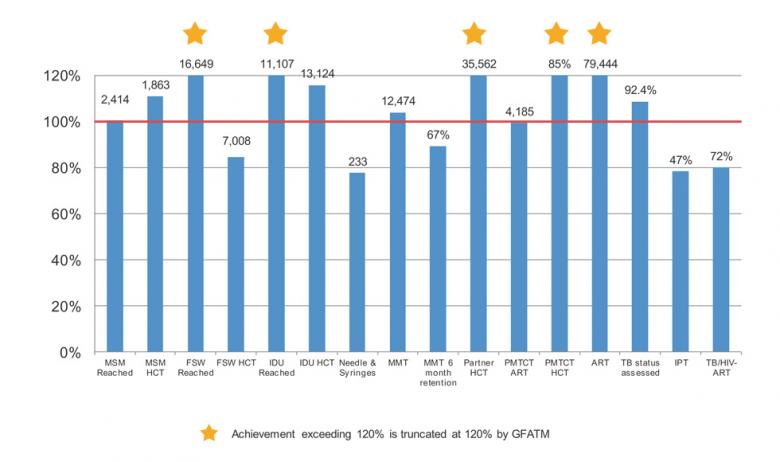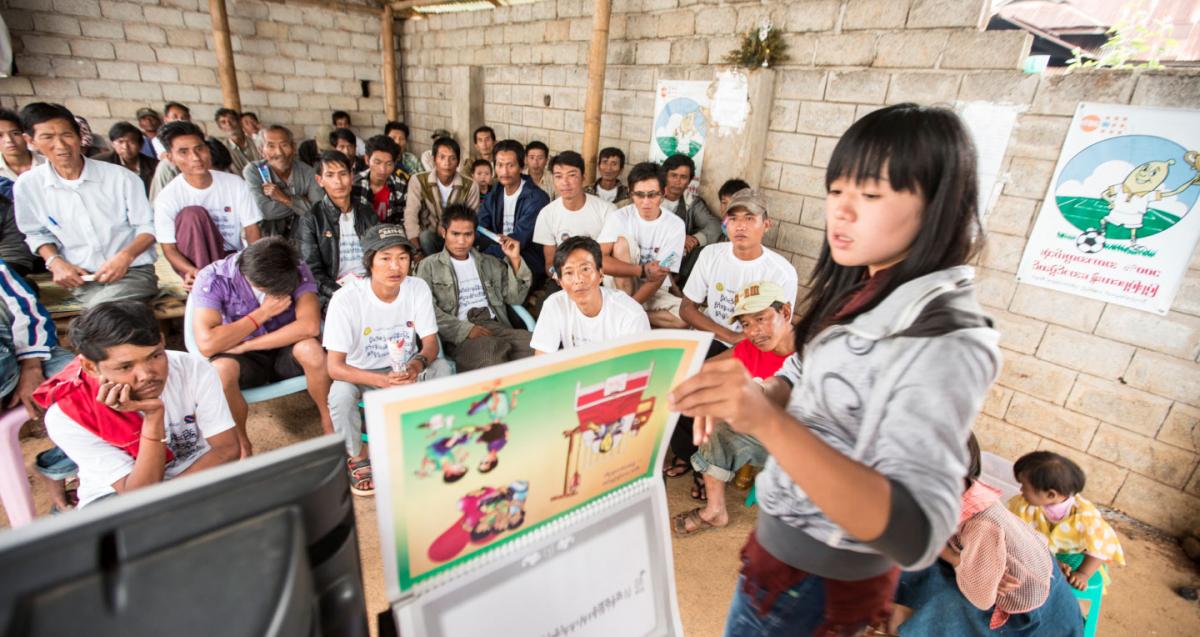
The cumulative results for Year 6 (NFM) are shown as a percentage of the annual target. The indicators on sex workers, men who have sex with men, and people who inject drugs reached, along with HIV counselling and testing and TB status assessed, are funded by GFATM only, whereas the others are funded by GFATM and other donors.
There has been significant progress in implementation of the HIV grant, with 10 out of 16 reportable indicators either meeting or exceeding 100 per cent of the annual target by the end of 2016.
By the end of 2016, 79,444 people living with HIV were receiving antiretroviral therapy (ART) (120% of the planned target for the year). Initiation of ART for all people living with HIV has been accelerated through ART scale-up in the public sector, with an increase in the number of ART sites to 95 and decentralized sites to 98. Increased community involvement has improved collaboration with the public sector and facilitated ART transition in terms of ART adherence and retention in care.
In 2016, 85 per cent (120% of target) of pregnant women received HIV counselling and testing and knew their test results, and 4,185 (99% of target) HIV-positive pregnant women received antiretroviral drugs to prevent mother-to-child transmission of HIV (PMTCT). PMTCT services were delivered in 308 townships and 38 hospitals in 2016.
In 2016, 2,414 (101% of target) men who have sex with men (MSM), 16,649 (120%) female sex workers (FSW) and 11,107 (120%) people who inject drugs (PWID) were reached with HIV prevention services.
Drop-in centres for key affected populations have provided "friendly spaces" where MSM and sex workers can discuss their personal issues, share experiences and access services, which include counselling, information on sexually transmitted infections, promoting voluntary HIV counselling and testing (HCT) and care for minor illnesses. Male and female condoms and lubricants were also provided free-of-charge.
In total, 7,008 (84%) FSW and 1,863 (111%) MSM underwent voluntary HIV testing and received their test results and post-test counselling. During the year, 13,124 (116%) PWID consented to HIV testing and received their test results.
At the end of 2016, 12,474 (104%) PWID had been enrolled into methadone maintenance therapy (MMT) in 46 MMT sites across the nation, and 67 per cent (89% of target) of persons who enrolled in MMT continued the treatment for at least six months. Moreover, the MMT programme has introduced additional integrated services for PWID under one roof, adopting a one-stop-shop model at 11 MMT sites.
The services provided under the one-stop-shop model include MMT; HCT; ART; targeted information, education and communication and condom programming for PWID and their sexual partners; testing and vaccination for hepatitis B; prevention, diagnosis and treatment of tuberculosis; testing for hepatitis C; and diagnosis and management of sexually transmitted infections.
In terms of needle and syringe distribution to PWID, the equivalent of 233 (78% of target) needles and syringes per person were distributed in 2016.
In 2016, 35,562 (120% of target) clients/partners of individuals belonging to key populations consented to HIV testing and received their test results and post-test counselling.
During the year, 78 per cent (47% of target) of new HIV-positive patients started isoniazid preventive therapy (IPT). This new indicator is being reported for the first time.
Some 72 per cent (80% of target) of people living with HIV who had TB coinfection had been enrolled on ART by the end of the year.


